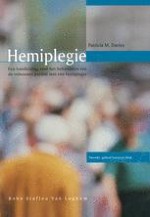Gepubliceerd in:
2001 | OriginalPaper | Hoofdstuk
3. Abnormale bewegingspatronen bij een hemiplegie
Abstract
Alle evenwichtsreacties en het vloeiende harmonieuze bewegingsverloop, zoals beschreven in hoofdstuk 2, zijn afhankelijk van een normale houdingstonus en sensibiliteit. Voorwaarde voor een normale tonus, sensibiliteit en beweging is een ongestoorde geleiding van zenuwimpulsen in een grote diversiteit aan houdingen en activiteiten, waarvoor een aanzienlijke mobiliteit in het zenuwstelsel zelf nodig is. Ieder verlies van neurodynamische eigenschappen van dit stelsel veroorzaakt onvermijdelijk veranderingen in spiertonus en bewegingspatronen, zoals wordt uitgelegd in hoofdstuk 15. ‘Wanneer iemand de normale mechanica van het zenuwstelsel verliest, verschijnen er bepaalde dynamische en statische houdingspatronen die ervoor zorgen dat de patiënt op een optimale manier kan omgaan met dit neurale bewegingsverlies’ (Butler 1991). Interessant is dat Butler als voorbeeld van een door het zenuwstelsel bepaalde, abnormale of ‘antalgische’ houding een beschrijving geeft die, hoewel het in zijn geval om een orthopedische patiënt gaat, veel houdingsafwijkingen vertoont die doorgaans worden geassocieerd met een hemiplegie. Alle actieve bewegingen treden op als gevolg van spiercontracties, maar men moet niet vergeten dat ‘een spier niet efficiënter kan werken dan de zenuw die de spier voorziet!’ (Rolf 1997b). Een gezond, mobiel zenuwstelsel is dus onontbeerlijk voor de uitvoering van normale bewegingen. De voor doelmatige functie vereiste gecoördineerde bewegingen en houdingsvariaties zijn tevens afhankelijk van het vermogen die lichaamsdelen die voor een bepaalde taak nodig zijn, selectief te bewegen en tegelijkertijd activiteit in de andere delen te inhiberen. Volgens Bach-y-Rita en Balliet (1987) ‘is inhibitie veel belangrijker dan algemeen wordt aangenomen; veel van wat wordt onderwezen legt de nadruk op excitatie, waarbij inhibitie eigenlijk wordt genegeerd’. In feite is inhibitie van overactiviteit een van de belangrijkste functies van het centrale zenuwstelsel en er lopen meer inhiberende banen dan exciterende banen in de hersenstam en het ruggenmerg. Met andere woorden: elke vaardigheid is omringd door een ‘muur van inhibitie’ (Kottke 1978). Wanneer een nieuwe vaardigheid wordt aangeleerd, neemt overactiviteit evenredig af via deze inhibitie, naarmate de uitvoerende persoon zich meer bekwaamt in de desbetreffende handeling(en).
